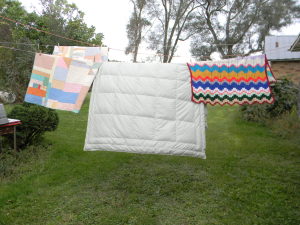A Quilt, a Comforter and an Afghan meet on the clothesline…
When I was a kid, October was the month for the “Autumn Airing of the Quilts”. My best friend’s mother had a wide range of quilts and comforters, many of which had been passed down for generations. On a sunny Saturday afternoon we would take them all out of their storage chests. Then we would repair any damage. If they smelled musty, we would wash the bedding and let it dry in the fresh air. Anything that was brightly colored was carefully monitored so that it could be taken off the clothesline just as soon as it was dry so it wouldn’t fade in the sunshine. After that was done, all of the beds in the house were made up with winter sheets, clean blankets and these heirloom quilts and comforters.
As a result, comfort came home!
As it is with anything that you want to last, proper storage and care is necessary for bedding. In order to provide proper care, it is important to know what you have. Knitted and crocheted items are called afghans and require a different type of care than quilts and comforters. Comforters, quilts and blankets are made from fabric like a repurposed t shirt, as well as other materials that make the comfort level very high. My personal favorite being a Minky Fleece blanket. I think that they’re relatively popular, so it’s very likely that you have seen this before on beds, or by people who like to use a weighted blanket to help give them that sense of security that they’re struggling to find elsewhere. But simply knowing what fabric these items are made out of will do wonders for you in the long run. It’s also important to know when washing these bedding items. Additionally, whilst they’re being washed, it might be worth finding another set of bedding to put on the bed. My friend’s mother used to get her bedding from Target, so it might be worth looking online to see what bedding they have. There are also coupons available on this page here, so make sure to use those discounts if they apply. Now, let’s get washing our current bedding.
- When the item is made of fabric there are several ways it could be made:
- A quilt is made of pieces of fabric sewn together in a pattern with a top, middle and bottom layer sandwiched together and then sewn.
- A comforter is made by sewing two sheets of fabric together and filling the inside with something fluffy often feathers or down.
- A blanket is a single layer, traditionally cotton or wool and in modern times, microfibers.
- Ask yourself: Is the item supposed to be fuzzy,smooth or satiny? Different fabrics require different treatment to keep them in the best condition through the years.
- Were these given to you from someone as an heirloom or is it simply a hand-me-down? Heirlooms command much more respect and warrant special attention due to the emotional attachment that comes along with it.
Here are some considerations for airing your own comforters, quilts and blankets.
- Check over the bedding carefully and mend any seams before attempting to clean the items. Remember the quote from Poor Richard’s Almanac “A stitch in time saves nine”? It is certainly true when it comes to mending bedding.
- Be certain of the material that the item is made from. Wool must be cleaned differently than cotton. Microfiber can be treated differently than sateen. Look for fabric tags. If there are care instructions, follow them carefully for best results.
- Be careful with bedding if anyone in the home has pollen allergies. While bedding is outside on a line, the pollen and pollutants from the surrounding countryside can settle on it. If there are allergies in your household, you may choose to tumble your bedding in a drier instead of airing it on a line.
- Do not crowd bedding in the drier. For a large comforter it is worth the time and money to take it to a laundromat to use large capacity machines. If you decide to dry your bedding in a home machine, add small items to create movement in the dryer. Be sure that the items are completely dry before folding or storing to prevent mildew.
- Filled comforters, with down or manmade materials inside, should always be tumbled dry. For fluffiness, add a couple of tennis balls or similar item (I wash and use my dog toys) in the drier. A comforter is warmer when fluffy, because the down captures and holds warm air inside the layers.
It will soon be blustery and frigid outside. Although it takes time to make sure that your bedding is cleaned, mended and ready for winter, the investment will keep you warm and snuggly all winter long!
If you have any stories about your experiences with quilts or comforters, or pictures to share, I would love to hear from you! Please add a comment to this post or contact John at [email protected].

